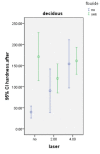Effects of Laser and Fluoride on the Prevention of Enamel Demineralization: An In Vitro Study
- PMID: 30809328
- PMCID: PMC6378360
- DOI: 10.15171/jlms.2018.32
Effects of Laser and Fluoride on the Prevention of Enamel Demineralization: An In Vitro Study
Abstract
Introduction: Investigations have demonstrated that fluoride is an essential element in preventive dentistry. However, there are still controversies about the preventive effects of various kinds of laser. The aim of this study was to examine the effect of diode laser irradiation (810 nm) with or without fluoride therapy in the prevention of deciduous enamel demineralization. Methods: Sixty deciduous molar crowns were randomly assigned to 6 groups: C: received no treatment; F: fluoride varnish application; 2L: 2 times diode laser irradiation; 4L: 4 times diode laser irradiation; F2L: 2 times laser irradiation over fluoride varnish; F4L: 4 times laser irradiation over fluoride varnish. Teeth in all groups were subjected to a pH-cycling process to produce artificial caries-like lesions. Results: The analysis of variance (ANOVA) of microhardness values indicated a significant great effect for laser, fluoride, and the interaction of laser- fluoride on reducing the final microhardness value (P<0.001). However, the 2L group was an exception. Despite the 4L group, it did not show a significant prevention of enamel microhardness loss (P=0.125). These 2 groups exhibited different effects in the absence of fluoride (P 2L-4L=0.05) while in the presence of the fluoride varnish, no statistically significant difference was observed between them (P F2L-F4L=0.257). Moreover, no statistically significant difference was observed between the laser-fluoride combination group and the fluoride group (P F2L-F=0.133, P F4L-F=0.926). Conclusion: Our results suggest that fluoride varnish, diode laser, and their combination decrease the loss of the enamel microhardness value and potentially prevent deciduous enamel demineralization. However, the combination of laser and fluoride was not more effective than fluoride.
Keywords: Demineralization; Diode laser; Fluoride; Primary tooth.
Similar articles
-
Effect of Nd:YAG laser combined with fluoride on the prevention of primary tooth enamel demineralization.Braz Dent J. 2012;23(2):104-9. doi: 10.1590/s0103-64402012000200003. Braz Dent J. 2012. PMID: 22666766
-
Effect of diode laser and fluoride varnish on initial surface demineralization of primary dentition enamel: an in vitro study.Int J Paediatr Dent. 2004 May;14(3):199-203. doi: 10.1111/j.1365-263X.2004.00550.x. Int J Paediatr Dent. 2004. PMID: 15139955 Clinical Trial.
-
Effects of topical fluoride on primary tooth enamel microhardness after diode laser treatment.Saudi Dent J. 2023 Dec;35(8):996-999. doi: 10.1016/j.sdentj.2023.10.016. Epub 2023 Oct 28. Saudi Dent J. 2023. PMID: 38107053 Free PMC article.
-
Effect of Diode Laser Irradiation Combined with Topical Fluoride on Enamel Microhardness of Primary Teeth.J Dent (Tehran). 2015 Feb;12(2):85-9. J Dent (Tehran). 2015. PMID: 26056517 Free PMC article.
-
Effect of CO2 Laser and Fluoride Varnish Application on Microhardness of Enamel Surface Around Orthodontic Brackets.J Lasers Med Sci. 2018 Winter;9(1):43-49. doi: 10.15171/jlms.2018.10. Epub 2017 Dec 26. J Lasers Med Sci. 2018. PMID: 29399311 Free PMC article.
Cited by
-
In vitro controlled elemental analysis to evaluate the combined effect of acidulated phosphate fluoride with Er:YAG and diode lasers.Can J Dent Hyg. 2023 Feb 1;57(1):25-32. eCollection 2023 Feb. Can J Dent Hyg. 2023. PMID: 36968800 Free PMC article.
-
Preventive effect of combined Er, Cr: YSGG and fluoride gel on acid resistance of the permanent tooth enamel: An in vitro study.J Clin Exp Dent. 2023 Mar 1;15(3):e225-e232. doi: 10.4317/jced.60023. eCollection 2023 Mar. J Clin Exp Dent. 2023. PMID: 37008246 Free PMC article.
-
Effect of Laser Irradiance and Fluoride Varnish on Demineralization Around Dental Composite Restorations.J Lasers Med Sci. 2020 Fall;11(4):450-455. doi: 10.34172/jlms.2020.70. Epub 2020 Oct 3. J Lasers Med Sci. 2020. PMID: 33425296 Free PMC article.
-
Effect of Diode Laser and Fluoride Varnish on Microhardness of enamel: An In Vitro Study.J Lasers Med Sci. 2024 Dec 26;15:e69. doi: 10.34172/jlms.2024.69. eCollection 2024. J Lasers Med Sci. 2024. PMID: 39949473 Free PMC article.
-
Effect of topical fluoride application and diode laser-irradiation on white spot lesions of human enamel.Saudi Dent J. 2021 Dec;33(8):937-943. doi: 10.1016/j.sdentj.2021.08.007. Epub 2021 Aug 23. Saudi Dent J. 2021. PMID: 34938035 Free PMC article.
References
-
- Petersen PE. The World Oral Health Report 2003: continuous improvement of oral health in the 21st century--the approach of the WHO Global Oral Health Programme. Community Dent Oral Epidemiol. 2003;31 Suppl 1:3–23. - PubMed
LinkOut - more resources
Full Text Sources
Medical



